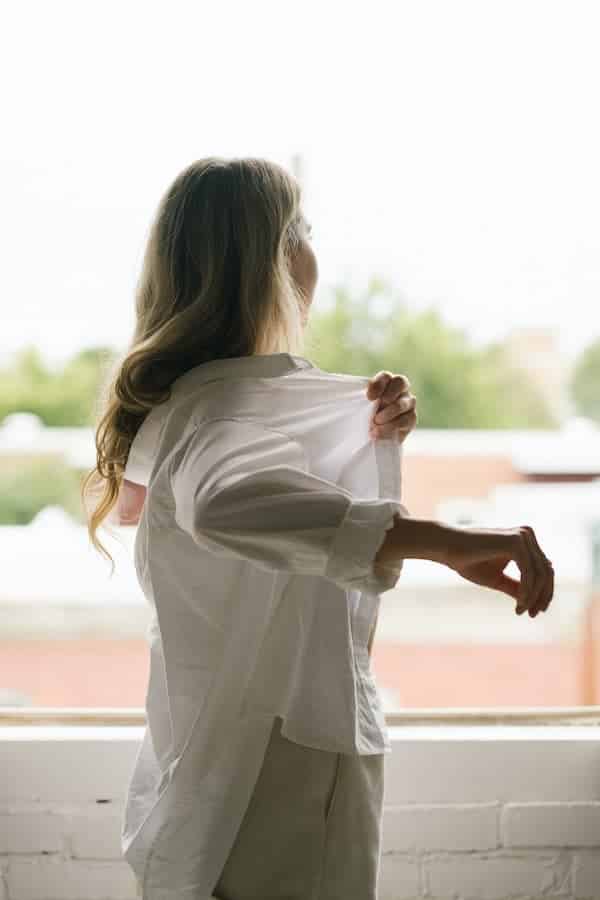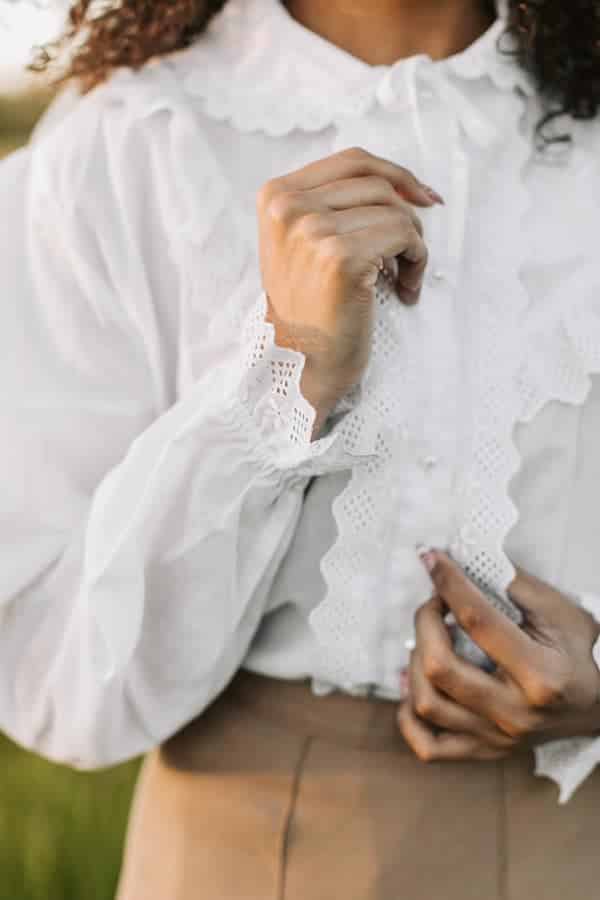Bleach is extremely effective at removing stains, killing bacteria, and giving you bleach-blonde hair. However, if it’s not used correctly, it can cause more problems than it solves.
You would think adding a drop of pure bleach to anything would help remove stains and make your whites, whiter. Sadly, this is not always the case!
Bleach is a harsh chemical, and needs to be diluted for most of its uses. The chlorine found in bleach is what causes the yellow marks left behind on white clothes.
Not only this, but it also removes the dye from colored clothes. No item in your wardrobe is safe!
So, what do you do to remove bleach stains on white clothing? And is it even possible? Thankfully, it is!
The most effective, simple method is to first rinse the stain, removing any excess bleach. After which you need to neutralize the bleach with baking soda. Then apply some white vinegar or dish soap to remove the stain.
There are a few different processes that need to happen, using things you probably have in your house. Keep reading to find out exactly what to do.
There may be affiliate links in this article. You can read more about this in my disclosure.
Can Bleach Stains be Totally Removed from White Clothes?

Without making any promises, the short answer is yes. The length of time the stain has been there will affect the results.
Bleach stains are best tackled immediately after they occur, and can often relatively easy to extract. Older stains may take a little more work and time, but they’re not impossible to remove.
Bleach stains are easier to remove from white clothing than colored ones.
This is because the bleach strips away the pigment from the colored item, and therefore to fix it, you have to restore the color that has been lost. Whereas, on white items, the bleach leaves a yellow residue that can be cleaned off.
Here are the Steps to Remove Beach Stains in White Clothing.
Step 1: Rinse Out the Bleach.
It’s best to rinse the stain with cool water as soon as possible. So, if your accident occurred in the last hour or so, put on some protective gloves and rinse it out now!
Removing any excess bleach will ensure the stain does not widen or worsen.
However, if your stain is old, this step will be less effective, but is still necessary. Bleach likes to cling to the dry fibers of your clothing, so will continue to disseminate as far as it can stretch of not washed away immediately.
Rinsing any bleach mark is still necessary because it is a dangerous chemical that may react when it comes into contact with some of the cleaning products in the following stages.
Step 2: Neutralise.
Before attempting to tackle the stain, it’s essential you neutralize the bleach first. This step stops the bleach from reacting any further, causing more damage to your clothing or releasing fumes.
Depending on the size of the stain, there are two methods to do this:
For smaller stains, the best method is to use baking soda. Gradually add water to a small bowl of baking soda until it forms a loose paste.
[amazon box=”B074J7X1DN” template=”vertical”]Wipe the paste onto the bleach stain, and leave it to dry. Once it has dried on, rise the paste off.
For a larger stain, or if the majority of the garment has been damaged, use 3% hydrogen peroxide.
[amazon box=”B07NFTM4ZY” template=”vertical”]Mix together 1 part hydrogen peroxide with 10 parts water. Submerge the garment in the mixture, and leave to soak for at least 10 minutes.
Remove the garment and rinse thoroughly with clean water.
Step 3: Removing the Stain.
There are a few different products you can use to do this, depending on what you have in your cupboards. Take a look in your kitchen and choose from white vinegar or dish soap.
How To Fix Bleach Stains with White Vinegar.
The most popular method is to use white vinegar, and for good reason. Vinegar is highly acidic and will dissolve the properties that cause the yellow bleach stain.
It’s critical you thoroughly rinse off any remaining chemicals, especially if you used the hydrogen peroxide soaking method of neutralisation.
Bleach can react with vinegar to create a toxic chlorine gas that is harmful to inhale. Rinse the item with cold water, and give it a sniff. If you can still smell bleach, rinse again.
Follow these steps using vinegar to remove bleach stains from white clothing:
- Add a tablespoon of white vinegar to 2 cups of water.
- Using a white cloth or paper towel, slowly dab the area with the mixture. You should be able to see the yellow mark begin to lighten. If the entire garment is stained, you can submerge the item in the solution and leave for 5 minutes.
- Continue dabbing the area until you can no longer see the stain.
- Wash the item normally to remove any remaining residue, and your stain should be gone! If the stains remains, repeat these steps or choose try the following method.
How to Remove Bleach Stains with Dish Soap.
If you dont have white vinegar in the house, I would be surprised if you didnt have any dish soap.
Although dish soap isnt as strong or aggressive as white vinegar, it can often be effective at lightening yellow marks. Its cleaning qualities penetrate stains and remove the discoloration.
Although you can’t normally wash away bleach blemishes with simple detergent, dishwashing soap is a little more powerful at lifting stains, especially small ones.
Additionally, this method works with or without using baking soda first. So if you only have this one product, you are still in with a good chance.
[amazon box=”B01MG2BJF0″ template=”vertical”]Follow these steps:
- Add 1 tablespoon of soap to 2 cups of tap water, and mix.
- Saturate a clean, white towel or cloth in the solution and begin dabbing the stain. Do not scrub the bleach mark, as you may simply spread it further. Definitely not ideal!
- Leave it to soak for 5-10 minutes.
- Blot the stain with a clean towel and cold water, then with a dry towel.
- Wash the item as normal along with the towels used in this method to remove any bleach residue.
Can I fix the stain with dye?
Technically, yes. But for white garments, you might have to transform the entire look of the garment to do so.
The bleached part of the item will not react the same to the dye as the other areas of the garment, so you may need to go for a tie-dying method. But, if you’re happy to reinvent the item, this could be a great method for you, and it could even be fun!
If you have a damaged colored item of clothing that you want to return to its original look, dye can be used. The main challenge is finding a dye that matches the original color of the item.
[amazon box=”B00AQ72WWQ” template=”vertical”]If you manage to find one, follow the dye package instructions and apply the dye to the stained area. Let dry, and rinse out.
This should help the stain blend in with the rest of the garment.
How do I Prevent Bleach Stains on White Clothes?
The biggest culprit for causing bleach stains is using bleach too often.
Over time, the entire garment will turn gradually more yellow, as the fibers wear away and degrade. Try not to use bleach on clothing unless it is heavily stained.
Bleach is extremely potent and needs to be diluted before use. Many people forget this as it’s such a standard household product, but it should never be used directly onto fabric.
Using bleach that is undiluted or too heavily concentrated will likely cause the fabric to hold on to some bleach. The garment will be difficult to fully rinse clean of bleach, and discoloration is likely to occur.
Obviously, if the bleach stain is caused by a cleaning accident, there is little you can do to prevent this. Simply consider wearing clothing that you do not mind getting damaged if you are planning on using bleach in the future.
Final Thoughts

Bleach is a powerful product that both removes pigment on colored fabrics, and leaves colorful stains on white garments.
Luckily, removing stains from white items is actually the easier of the two challenges. Even if you only have dish soap in the house, these stubborn marks can be tackled.
However, if you have vinegar lying around, it’s definitely the most powerful tool to use on stained white clothing. Hopefully one of the methods for stain removal worked for you, and if not, tie dye is always in fashion, so hope is not lost!



